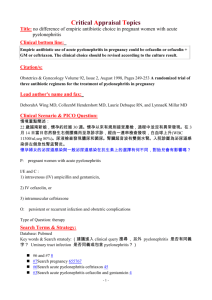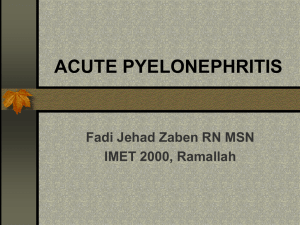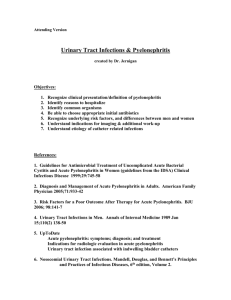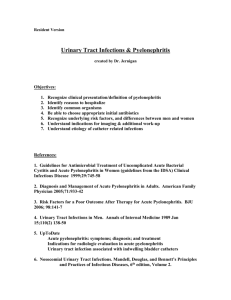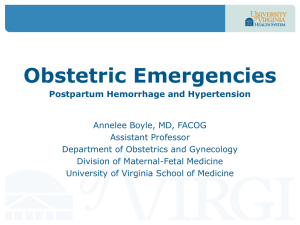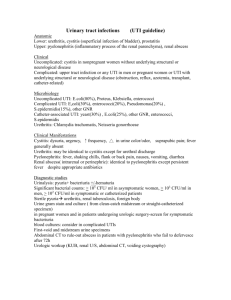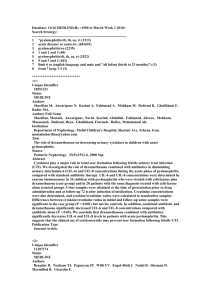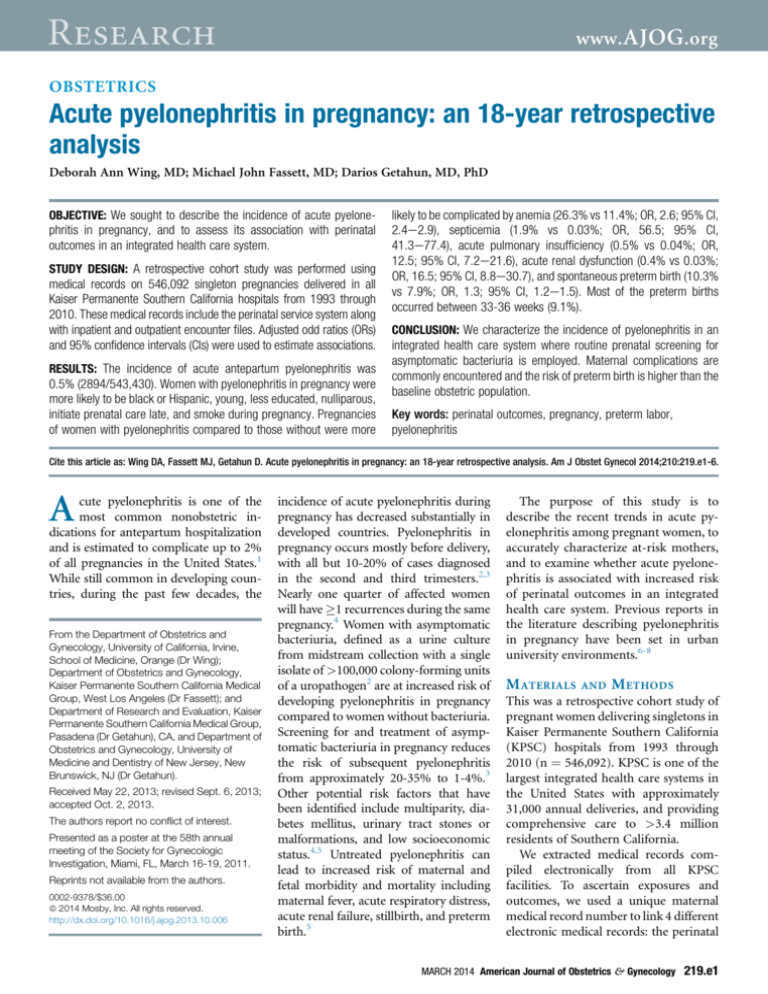
Research
www.AJOG .org
OBSTETRICS
Acute pyelonephritis in pregnancy: an 18-year retrospective
analysis
Deborah Ann Wing, MD; Michael John Fassett, MD; Darios Getahun, MD, PhD
OBJECTIVE: We sought to describe the incidence of acute pyelone-
phritis in pregnancy, and to assess its association with perinatal
outcomes in an integrated health care system.
STUDY DESIGN: A retrospective cohort study was performed using
medical records on 546,092 singleton pregnancies delivered in all
Kaiser Permanente Southern California hospitals from 1993 through
2010. These medical records include the perinatal service system along
with inpatient and outpatient encounter files. Adjusted odd ratios (ORs)
and 95% confidence intervals (CIs) were used to estimate associations.
RESULTS: The incidence of acute antepartum pyelonephritis was
0.5% (2894/543,430). Women with pyelonephritis in pregnancy were
more likely to be black or Hispanic, young, less educated, nulliparous,
initiate prenatal care late, and smoke during pregnancy. Pregnancies
of women with pyelonephritis compared to those without were more
likely to be complicated by anemia (26.3% vs 11.4%; OR, 2.6; 95% CI,
2.4e2.9), septicemia (1.9% vs 0.03%; OR, 56.5; 95% CI,
41.3e77.4), acute pulmonary insufficiency (0.5% vs 0.04%; OR,
12.5; 95% CI, 7.2e21.6), acute renal dysfunction (0.4% vs 0.03%;
OR, 16.5; 95% CI, 8.8e30.7), and spontaneous preterm birth (10.3%
vs 7.9%; OR, 1.3; 95% CI, 1.2e1.5). Most of the preterm births
occurred between 33-36 weeks (9.1%).
CONCLUSION: We characterize the incidence of pyelonephritis in an
integrated health care system where routine prenatal screening for
asymptomatic bacteriuria is employed. Maternal complications are
commonly encountered and the risk of preterm birth is higher than the
baseline obstetric population.
Key words: perinatal outcomes, pregnancy, preterm labor,
pyelonephritis
Cite this article as: Wing DA, Fassett MJ, Getahun D. Acute pyelonephritis in pregnancy: an 18-year retrospective analysis. Am J Obstet Gynecol 2014;210:219.e1-6.
A
cute pyelonephritis is one of the
most common nonobstetric indications for antepartum hospitalization
and is estimated to complicate up to 2%
of all pregnancies in the United States.1
While still common in developing countries, during the past few decades, the
From the Department of Obstetrics and
Gynecology, University of California, Irvine,
School of Medicine, Orange (Dr Wing);
Department of Obstetrics and Gynecology,
Kaiser Permanente Southern California Medical
Group, West Los Angeles (Dr Fassett); and
Department of Research and Evaluation, Kaiser
Permanente Southern California Medical Group,
Pasadena (Dr Getahun), CA, and Department of
Obstetrics and Gynecology, University of
Medicine and Dentistry of New Jersey, New
Brunswick, NJ (Dr Getahun).
Received May 22, 2013; revised Sept. 6, 2013;
accepted Oct. 2, 2013.
The authors report no conflict of interest.
Presented as a poster at the 58th annual
meeting of the Society for Gynecologic
Investigation, Miami, FL, March 16-19, 2011.
Reprints not available from the authors.
0002-9378/$36.00
ª 2014 Mosby, Inc. All rights reserved.
http://dx.doi.org/10.1016/j.ajog.2013.10.006
incidence of acute pyelonephritis during
pregnancy has decreased substantially in
developed countries. Pyelonephritis in
pregnancy occurs mostly before delivery,
with all but 10-20% of cases diagnosed
in the second and third trimesters.2,3
Nearly one quarter of affected women
will have 1 recurrences during the same
pregnancy.4 Women with asymptomatic
bacteriuria, defined as a urine culture
from midstream collection with a single
isolate of >100,000 colony-forming units
of a uropathogen2 are at increased risk of
developing pyelonephritis in pregnancy
compared to women without bacteriuria.
Screening for and treatment of asymptomatic bacteriuria in pregnancy reduces
the risk of subsequent pyelonephritis
from approximately 20-35% to 1-4%.3
Other potential risk factors that have
been identified include multiparity, diabetes mellitus, urinary tract stones or
malformations, and low socioeconomic
status.4,5 Untreated pyelonephritis can
lead to increased risk of maternal and
fetal morbidity and mortality including
maternal fever, acute respiratory distress,
acute renal failure, stillbirth, and preterm
birth.5
The purpose of this study is to
describe the recent trends in acute pyelonephritis among pregnant women, to
accurately characterize at-risk mothers,
and to examine whether acute pyelonephritis is associated with increased risk
of perinatal outcomes in an integrated
health care system. Previous reports in
the literature describing pyelonephritis
in pregnancy have been set in urban
university environments.6-8
M ATERIALS
AND
M ETHODS
This was a retrospective cohort study of
pregnant women delivering singletons in
Kaiser Permanente Southern California
(KPSC) hospitals from 1993 through
2010 (n ¼ 546,092). KPSC is one of the
largest integrated health care systems in
the United States with approximately
31,000 annual deliveries, and providing
comprehensive care to >3.4 million
residents of Southern California.
We extracted medical records compiled electronically from all KPSC
facilities. To ascertain exposures and
outcomes, we used a unique maternal
medical record number to link 4 different
electronic medical records: the perinatal
MARCH 2014 American Journal of Obstetrics & Gynecology
219.e1
Research
www.AJOG.org
Obstetrics
services system, maternal and infant
hospitalization records, maternal outpatient health care encounters records, and
laboratory records. The perinatal services
system records contain maternal sociodemographic (age, race/ethnicity, education) and behavioral (smoking during
pregnancy, timing of prenatal care initiation) characteristics as well as birthweight and gestational age at delivery
from the infants’ birth certificate. The
maternal and infant hospitalization and
outpatient physician encounter records
include International Classification of
Diseases, Ninth Revision (ICD-9), Clinical
Modification (ICD-9-CM) codes from
which we derived maternal medical history, obstetrical history, and procedures
for services throughout KPSC. Microbiology laboratory records of each acute
pyelonephritis patient were reviewed for
the presence of uropathogens in the
culture results. The study was approved
by the KPSC Institutional Review Board.
Variables that were evaluated as potential confounders or mediators included maternal age (<20, 20-29, 30-34,
35 years); race/ethnicity categorized
as non-Hispanic white (white), nonHispanic black (black), Hispanic, Asian/
Pacific Islander, and other race/ethnicity;
maternal education (<12, 12, and 13
years of completed schooling); maternal
smoking during pregnancy (yes/no);
timing of initial prenatal care (first
trimester, later or none); parity (0, 1,
2); medical conditions (chronic hypertension and pregestational diabetes);
gestational diabetes; and birth year (1993
through 1995, 1996 through 1998, 1999
through 2001, 2002 through 2004, 2005
through 2007, and 2008 through 2010).
Since the annual incidence rates for acute
pyelonephritis were low, we chose to
combine 3 years of records for statistical
stability.
We used (ICD-9) codes 590.x to
identify acute pyelonephritis. This and all
subsequent diagnoses were made clinically and confirmed by laboratory tests.
The outcome of interest examined in this
study were: anemia (anemia complicating pregnancy childbirth or the puerperium; ICD-9 codes 648.2x), septicemia
(systemic inflammatory response syndrome; ICD-9 codes 995.9x), acute renal
failure (an abrupt or rapid decline in
renal filtration function; ICD-9 codes
584.x and 669.x), respiratory distress
(ICD-9 codes 518.8x), spontaneous preterm birth (a premature labor and delivery occurring at 20-36 completed
weeks of gestation [grouped into blocks
of 20-28, 29-33, and 34-36 weeks of
gestation]), stillbirth (the intrauterine
death of an infant >20 completed weeks
of gestation), chorioamnionitis (an inflammation at the maternal-fetal interface; ICD-9 codes 762.7x and 658.4x),
preeclampsia (hypertensive disorder >20
weeks of pregnancy, combined with
proteinuria and/or edema; ICD-9 codes
642.4 and 642.5), and neonatal death
(the death of a live born infant within
28 days of life). The exposure variable of
interest was acute antepartum pyelonephritis (ICD-9-CM codes 590.1x).
We validated the accuracy of the ICD9-CM coding by abstracting a random
sample of 400 medical records. For this
validation study, pregnancies resulting
in low birthweight or premature births
were oversampled to ensure adequate
number of these risk factors to be
reviewed. Because we applied a stratified
sampling approach, the accuracy measures were estimated using weighted analyses. Abstracted records were compared
with diagnosis codes collected electronically. After adjusting for sampling fractions, the estimated sensitivity, specificity,
and positive and negative predictive
values were 97%, 99%, 97%, and 99% for
anemia; 100%, 99%, 92%, and 100% for
chorioamnionitis; 82%, 95%, 74%, and
97% for group B streptoccus infection;
92%, 98%, 80%, and 99% for gestational
fever; and 97%, 97%, 68%, and 100% for
preeclampsia, respectively. These findings
support the validity of the diagnosis codes
in our study.
Gestational age data are based on a
clinical estimate of gestational age and
were categorized into 3 groups: 20-28,
29-33, and 34-36 weeks as well as term
birth (37-42 weeks).
From 1993 through 2010, there were
546,092 singleton live births and fetal
deaths recorded in all KPSC hospitals.
We sequentially excluded births at <20
weeks’ gestation (n ¼ 1707), and early
termination of pregnancy (n ¼ 922).
219.e2 American Journal of Obstetrics & Gynecology MARCH 2014
After exclusions, a total of 543,463
singleton pregnancies at 20 weeks of
gestation remained for analysis.
Statistical analyses
We estimated the incidence of acute pyelonephritis diagnosis among singleton
pregnant women delivered in all KPSC
hospitals. Second, we compared the
maternal demographic and behavioral
characteristics between women with and
without acute pyelonephritis using the
c2 test. Differences with P < .05 were
considered statistically significant. Third,
logistic regression models were applied
to examine the associations between
maternal characteristics and acute pyelonephritis before and after adjusting for
several potential confounding factors.
Fourth, we further examined the association between acute pyelonephritis and
perinatal outcomes after accounting for
the effects of potential confounding factors listed in Table 1. The analyses were
also stratified by spontaneous preterm
birth into 3 groups defined above and
by low birthweight (<1500 g and 15002499 g) categories to determine if associations were modified by these factors.
The strength of the associations was
explored based on the odds ratios (ORs)
and their 95% confidence intervals (CIs).
All analyses were performed using software (SAS, version 9.2; SAS Institute,
Cary, NC).
R ESULTS
During the 18-year study period, 2894
cases of acute antepartum pyelonephritis
were identified, for an incidence level of
5.3 per 1000 births. Rates gradually increase from 4.6 per 1000 births in 1993
to 5.9 per 1000 births in 2010, reflecting
a relative increase over the time period of
29%; P value for linear trends < .001.
Most cases of acute pyelonephritis were
diagnosed in the second and third
trimester of pregnancy, accounting for
90.8% of cases in this analysis. Women
were hospitalized for a mean of 2.8 days
(SD 1.7). Women who were diagnosed
with acute antepartum pyelonephritis
were more likely to be younger, have
fewer years of education, be of black
or Hispanic ethnicity, smoke during
pregnancy, initiate prenatal care late in
www.AJOG.org
their pregnancy, and be nulliparous
compared to women who were not
diagnosed with acute pyelonephritis in
pregnancy (Table 1).
The association between maternal
characteristics and acute pyelonephritis
during pregnancy is shown in Table 2.
Compared with women 20-29 years old,
women who were <20 years old were
more likely to have a pregnancy complicated by acute pyelonephritis (OR, 2.0;
95% CI, 1.8e2.3). Compared with white
women, Hispanic and black women were
at significantly increased risk of acute
pyelonephritis during their pregnancy,
however, the risk for black women disappeared after adjusting for multiple
confounders. Compared with women
who had 13 years of formal education,
women who completed 12 years of education had significantly increased risk
of acute pyelonephritis (OR, 1.3; 95%
CI, 1.2e1.5) as were women who had
<12 years of formal education (OR, 1.5;
95% CI, 1.4e1.7). Late initiation of
prenatal care and smoking during pregnancy were each associated with 1.1-fold
increased risk of acute pyelonephritis.
Pregnancy complicated by pregestational
diabetes was associated with 1.7-fold
(95% CI, 1.3e2.1) increased risk of
acute pyelonephritis.
We did not find significant differences
in the frequencies of medical complications such as chronic hypertension and
gestational diabetes between those women
with and without the diagnosis of pyelonephritis. Table 3 shows findings on
the association between acute pyelonephritis during pregnancy and adverse
perinatal outcomes. Women with acute
pyelonephritis during pregnancy were at
significantly increased risk of anemia
(OR, 2.6; 95% CI, 2.4e2.9), septicemia
(OR, 56.5; 95% CI, 41.3e77.4), acute
renal failure (OR, 16.5; 95% CI,
8.8e30.7), respiratory distress (OR, 12.5;
95% CI, 7.2e21.6), spontaneous preterm birth (OR, 1.3; 95% CI, 1.2e1.5),
and low birthweight birth (OR, 1.3; 95%
CI, 1.1e1.5) compared to women
without. Nearly 10% of women diagnosed with acute pyelonephritis delivered prematurely, compared to 7.9%
without the condition. Most of these
spontaneous preterm births occurred
Obstetrics
Research
TABLE 1
Distribution of maternal and infant characteristics based on
pyelonephritis status
No pyelonephritis
n [ 540,536 (%)
Characteristics
Pyelonephritis
n [ 2894 (%)
Maternal age, ya
<20
7.7
21.1
20-29
47.9
52.9
30-34
27.0
16.5
17.4
9.5
Non-Hispanic white
27.0
21.9
Non-Hispanic black
10.5
11.1
Hispanics
49.2
58.4
Asian/Pacific Islanders
10.9
6.2
2.4
2.4
<12
13.7
22.2
12
30.8
37.3
13
50.8
36.4
15.0
20.1
9.9
11.9
Primigravida
29.2
37.5
Multigravida
70.8
62.5
Nullipara
39.9
48.6
Multipara
60.1
51.4
35
Maternal race
a
Others/unknown
Maternal education, y
a
Late initiation of prenatal carea
Smoking during pregnancy
Gravida
Parity
a
a
a
Chronic hypertension
3.3
3.1
Pregestational diabetes
2.2
2.9
Gestational diabetes
9.5
8.2
1993 through 1995
15.0
15.4
1996 through 1998
17.2
16.0
1999 through 2001
17.6
14.7
2002 through 2004
16.4
14.4
2005 through 2007
16.6
16.6
2008 through 2010
17.2
22.9
Year of delivery
a
a
Differences between pyelonephritis and no pyelonephritis by maternal and infant characteristics were statistically significant
(P < .001).
Wing. Acute pyelonephritis in pregnancy. Am J Obstet Gynecol 2014.
between 33-36 weeks’ gestational age.
Acute pyelonephritis was also associated
with increased risk of chorioamnionitis
(OR, 1.3; 95% CI, 1.1e1.5) and primary
cesarean delivery (OR, 1.2; 95% CI,
1.1e1.3). However, acute pyelonephritis
MARCH 2014 American Journal of Obstetrics & Gynecology
219.e3
Research
www.AJOG.org
Obstetrics
TABLE 2
Association between maternal characteristics and acute pyelonephritis
OR (95% CI)
Crude
Adjusteda
<20
2.5 (2.3e2.7)
2.0 (1.8e2.3)
20-29
1.0 (Ref)
1.0 (Ref)
30-34
0.6 (0.5e0.7)
0.6 (0.5e0.7)
0.5 (0.4e0.6)
0.5 (0.4e0.6)
Non-Hispanic white
1.0 (Ref)
1.0 (Ref)
Non-Hispanic black
1.3 (1.1e1.5)
1.1 (0.9e1.2)
Hispanics
1.5 (1.3e1.6)
1.2 (1.1e1.3)
Asian/Pacific Islanders
0.7 (0.6e0.8)
0.8 (0.7e0.9)
Others/unknown
1.2 (1.0e1.6)
1.1 (0.8e1.4)
<12
2.3 (2.0e2.5)
1.5 (1.4e1.7)
12
1.7 (1.6e1.8)
1.3 (1.2e1.5)
1.0 (Ref)
1.0 (Ref)
1.4 (1.3e1.5)
1.1 (1.0e1.2)
1.2 (1.1e1.4)
1.1 (1.0e1.3)
Primigravida
1.0 (Ref)
1.0 (Ref)
Multigravida
0.7 (0.6e0.8)
1.1 (0.9e1.2)
Nullipara
1.0 (Ref)
1.0 (Ref)
Multipara
0.7 (0.6e0.8)
0.9 (0.8e1.0)
Chronic hypertension
0.9 (0.8e1.4)
1.0 (0.8e1.3)
Pregestational diabetes
1.3 (1.1e1.6)
1.7 (1.3e2.1)
Gestational diabetes
0.9 (0.7e1.0)
1.0 (0.9e1.1)
1993 through 1995
1.0 (Ref)
1.0 (Ref)
1996 through 1998
0.9 (0.8e1.0)
0.9 (0.8e1.1)
1999 through 2001
0.8 (0.7e0.9)
0.8 (0.7e1.0)
2002 through 2004
0.9 (0.7e1.0)
0.9 (0.8e1.1)
2005 through 2007
1.0 (0.9e1.1)
1.1 (0.9e1.2)
2008 through 2010
1.3 (1.2e1.5)
1.5 (1.3e1.7)
Characteristics
Maternal age, ya
35
Maternal race
a
a
Maternal education, y
13
Late initiation of prenatal care
Smoking during pregnancy
a
a
Gravidaa
Parity
a
Year of delivery
a
CI, confidence interval; OR, odds ratio; Ref, reference.
a
Adjustments were made for other variables in table.
Wing. Acute pyelonephritis in pregnancy. Am J Obstet Gynecol 2014.
was not associated with increased risk
of very low birthweight, preeclampsia,
stillbirth, or neonatal mortality.
In those pregnant women with acute
pyelonephritis, urine cultures identified
pathogens in 1887 (65.2%) subjects.
219.e4 American Journal of Obstetrics & Gynecology MARCH 2014
The frequencies of uropathogenic bacteria isolated included: Escherichia coli
(82.5%), Streptococcus species (21.4%),
Klebsiella pneumoniae (7.6%), Staphylococcus species (6.5%), Proteus mirabilis
(4.9%), and Enterococcus species (5.7%).
Of those women who developed adult
respiratory distress syndrome (ARDS)
in association with pyelonephritis, the
causative microorganisms were: Escherichia coli (50%), Staphylococcus species
(14.3%), P mirabilis (7.1%), Enterococcus
species (7.1%), and Streptococcus species
(7.1%).
C OMMENT
Overall, 0.5% of the pregnant women
included in this study were hospitalized
for acute pyelonephritis, which is less
than historical reports.9 We speculate
that the implementation of the guidelines for screening for asymptomatic
bacteriuria in pregnancy by the US Preventative Health Task Force10 and the
American College of Obstetricians and
Gynecologists11 may be partly responsible for this, leading to greater detection
and treatment of this predecessor to
many cases of pyelonephritis. It is also
possible the high rates of early entry into
prenatal care and the population characteristics might have contributed to the
observed low rate.
Compared with women without a
diagnosis of acute pyelonephritis, women
who were diagnosed with acute pyelonephritis in pregnancy in this managed
care organization were more likely to be
<29 years of age, less educated, Hispanic
or black, and nulliparous. As with previous investigations we found associations
with lower educational achievement
levels and late entry to prenatal care.
These may be markers of lower socioeconomic status, a known association
with the development of acute pyelonephritis in pregnancy.4,7,8,12,13 We did not
find associations with chronic hypertension, nor did we find associations with
gestational diabetes.
We also demonstrated increasing frequencies of pyelonephritis when analyzing our data in 3-year epochs. We
speculate that despite increased adherence to guidelines recommending routine
screening for asymptomatic bacteruria in
www.AJOG.org
Obstetrics
Research
TABLE 3
Associations between pyelonephritis and perinatal outcome measures
Unadjusted
OR (95% CI)
Adjusteda
OR (95% CI)
Outcomes
No pyelonephritis
n [ 540,536 (%)
Pyelonephritis
n [ 2894 (%)
Anemia
11.4
26.3
2.8 (2.6e3.0)
2.6 (2.4e2.9)
Septicemia
0.03
1.9
59.9 (44.3e81.1)
56.5 (41.3e77.4)
Acute renal failure
0.03
0.4
14.8 (8.0e27.4)
16.5 (8.8e30.7)
Respiratory distress/ARDS
0.04
0.5
12.9 (7.5e22.3)
12.5 (7.2e21.6)
<37
7.9
10.3
1.3 (1.2e1.5)
1.3 (1.2e1.5)
20-27
0.6
0.7
1.1 (0.7e1.7)
1.1 (0.7e1.8)
28-32
1.1
1.2
1.2 (0.8e1.6)
1.2 (0.8e1.6)
33-36
6.2
9.1
1.4 (1.2e1.6)
1.4 (1.2e1.6)
<1500
1.2
1.4
1.2 (0.9e1.7)
1.2 (0.9e1.7)
1500-2499
4.2
5.5
1.3 (1.1e1.6)
1.3 (1.1e1.5)
Chorioamnionitis
3.4
4.5
1.3 (1.1e1.6.)
1.3 (1.1e1.5)
Spontaneous preterm birth, wk
Low birthweight, g
Preeclampsia
5.1
5.5
1.1 (.0.9e1.3)
1.0 (0.9e1.2)
13.5
14.9
1.1 (1.0e1.3)
1.2 (1.1e1.3)
Stillbirth
0.4
0.3
0.8 (0.4e1.5)
0.9 (0.4e1.8)
Neonatal death
0.3
0.2
0.8 (0.4e1.7)
0.8 (0.4e1.7)
Primary cesarean
ARDS, adult respiratory distress syndrome; CI, confidence interval; OR, odds ratio.
a
Analyses were adjusted for maternal age, race/ethnicity, education, prenatal care, gravida, chronic hypertension, pregestational and gestational diabetes, smoking during pregnancy, and year of
delivery.
Wing. Acute pyelonephritis in pregnancy. Am J Obstet Gynecol 2014.
pregnancy, other age-related comorbidities may place the population at increased
risk for pyelonephritis.
The uropathogens identified in this
investigation were consistent with previous reports.3,8,14,15 Because of the nature of the investigation, we could not
profile chronologic differences in the
appearance of some of these uropathogens as has been done by others,8
although the appearance in later gestations concurs with findings of others.16
Anemia, the most common complication associated with pyelonephritis,
occurs historically in approximately 25%
of patients; our findings are similar.8 The
low frequency of ARDS in our investigation (0.5%) was considerably less than
historic reports that reflect a range from
1-8%.7,17 Our result may reflect improvements in treatment for acute
antepartum pyelonephritis with judicious intravenous fluid management and
rapid initiation of antimicrobial therapy.
It is also possible that underreporting
is responsible, a limitation imposed by
retrospective analysis. Contrary to previous reports however,18 the most common uropathogen identified in women
with ARDS and pyelonephritis was
Escherichia coli, not K pneumoniae. In
fact, none of the cases of ARDS were due
to K pneumoniae.
Approximately 15-20% of women
with pyelonephritis will have bacteremia.8,14,15 Gram-negative bacteria possess endotoxin that, when released into
the maternal circulation, can lead to a
cascade response of cytokines, histamine, and bradykinin. The resulting
capillary endothelial damage, diminished vascular resistance, and alterations
in cardiac output may lead to serious
complications such as septic shock,
disseminated intravascular coagulation,
respiratory insufficiency, or ARDS. In a
review of admissions for antepartum
pyelonephritis in a major metropolitan
center over 2 years, 17% of patients were
also septicemic.8 A separate analysis
noted that 12% of antepartum admissions to the obstetric intensive care unit
at the same institution were for sepsis
caused by pyelonephritis.19,20 Our results indicated a nearly 2% frequency
of septicemia in association with acute
pyelonephritis, nearly 50 times that of
women without. This may reflect differences in socioeconomic status of our
subjects diagnosed with gestational pyelonephritis and septicemia that permit
earlier access to medical care and/or
adherence to standardized protocols for
treatment of this infectious complication
of pregnancy that lead to improvements
and perhaps prevention of this added
complication.
Because blood cultures were not universally obtained, we could not assess the
MARCH 2014 American Journal of Obstetrics & Gynecology
219.e5
Research
www.AJOG.org
Obstetrics
frequency of bacteremia in our cohort.
In fact, in only 841 of the 2949 cases
of acute pyelonephritis cases in pregnancy were blood cultures performed.
The limited utility of blood cultures in
the management of pyelonephritis in
pregnancy has been commented on
previously.21
The exact risk of preterm labor and
delivery directly attributable to pyelonephritis in pregnancy is difficult to estimate, particularly because delivery may
not occur during the admission for the
acute disease, and the risk factors for
both pyelonephritis and preterm delivery overlap.22 Nonetheless, our results
indicate that women with a diagnosis of
acute pyelonephritis in pregnancy have a
modestly higher likelihood of preterm
delivery compared to women without
(10.3% vs 7.9%, P < .001). Our results
are substantially higher than those of 368
women delivered at Parkland Hospital
(Dallas, TX) with a history of pyelonephritis during the pregnancy. Of them,
19 of 368 (5%) delivered at <37 weeks,
and only 4 of 368 (1%) delivered preterm during their admission for acute
pyelonephritis.8
The strengths of this study include its
population-based nature that includes a
racially and ethnically diverse population of pregnant women and taking into
account several potential confounding
factors. The large number of cases and
standardized approaches to medical care
with basis in a large integrated health
care system are added benefits. Another
strength of the study was repeated validation of the clinical diagnosis codes
using medical record gold standards.
Limitations of this study include its
retrospective nature, and the possibility
of potential confounders that were not
accounted for (residual confounding)
in this study. By the nature of this
examination, we were unable to evaluate
the temporality of the appearance of
these risk factors or complications
related to the diagnosis of acute pyelonephritis in pregnancy. Therefore, the
associations found between acute pyelonephritis and the various perinatal
outcome measures in this study do not
imply causality. Lastly, the small number
of patients with blood culture tests precluded assessment of bacteremia in our
cohort.
The findings of this study confirm that
the diagnosis of acute antepartum pyelonephritis increased during the study
period. It further underscores that acute
pyelonephritis is an important complication of pregnancy, and a major cause
of perinatal morbidity.
-
REFERENCES
1. Gilstrap LC III, Ramin SM. Urinary tract infections during pregnancy. Obstet Gynecol Clin
North Am 2001;28:581-91.
2. Nicolle LE, Bradley S, Colgan R, Rice JC,
Schaeffer A, Hooton TM. Infectious Diseases
Society of America guidelines for the diagnosis
and treatment of asymptomatic bacteriuria in
adults. Clin Infect Dis 2005;40:643-54.
3. Duff P. Pyelonephritis in pregnancy. Clin
Obstet Gynecol 1984;27:17-31.
4. Sheffield JS, Cunningham FG. Urinary tract
infection in women. Obstet Gynecol 2005;106:
1085-92.
5. Farkash E, Weintraub AY, Sergienko R,
Wiznitzer A, Zlotnik A, Sheiner E. Acute antepartum pyelonephritis in pregnancy: a critical
analysis of risk factors and outcomes. Eur J
Obstet Gynecol Reprod Biol 2012;162:24-7.
6. Gilstrap LC III, Cunningham FG, Whalley PJ.
Acute pyelonephritis in pregnancy: an anterospective study. Obstet Gynecol 1981;57:
409-13.
7. Cunningham FG, Morris GB, Mickal A. Acute
pyelonephritis of pregnancy: a clinical review.
Obstet Gynecol 1973;42:112-7.
8. Hill JB, Sheffield JS, McIntire DD,
Wendel GD Jr. Acute pyelonephritis in pregnancy. Obstet Gynecol 2005;105:18-23.
219.e6 American Journal of Obstetrics & Gynecology MARCH 2014
9. Bacak SJ, Callaghan WM, Dietz PM,
Crouse C. Pregnancy-associated hospitalizations in the United States, 1999-2000. Am J
Obstet Gynecol 2005;192:592-7.
10. US Preventive Services Task Force.
Screening for asymptomatic bacteriuria in
adults, topic page. Available at: http://www.
uspreventiveservicestaskforce.org/uspstf/
uspsbact.htm. Accessed June 11, 2013.
11. American Academy of Pediatrics, American
College of Obstetricians and Gynecologists.
Chapter 4: Antepartum care. Guidelines for
perinatal care, 6th ed. Elk Grove Village, IL: AAP;
Washington, DC: ACOG; 2007.
12. Jolley JA, Wing DA. Pyelonephritis in pregnancy: an update on treatment options for
optimal outcomes. Drugs 2010;70:1643-55.
13. Scholes D, Hooton TM, Roberts PL,
Gupta K, Stapleton AE, Stamm WE. Risk factors
associated with acute pyelonephritis in healthy
women. Ann Intern Med 2005;142:20-7.
14. Wing DA, Hendershott CM, Debuque L,
Millar LK. Outpatient treatment of acute pyelonephritis in pregnancy after 24 weeks. Obstet
Gynecol 1999;94:683-8.
15. Wing DA. Pyelonephritis in pregnancy:
treatment options for optimal outcomes. Drugs
2001;61:2087-96.
16. Archabald KL, Friedman A, Raker CA,
Anderson BL. Impact of trimester on morbidity of
acute pyelonephritis in pregnancy. Am J Obstet
Gynecol 2009;201:406.e1-4.
17. Cunningham FG, Lucas MJ, Hankins GD.
Pulmonary injury complicating antepartum pyelonephritis. Am J Obstet Gynecol 1987;156:
797-807.
18. Towers CV, Kaminskas CM, Garite TJ,
Nageotte MP, Dorchester W. Pulmonary injury
associated with antepartum pyelonephritis: can
patients at risk be identified? Am J Obstet
Gynecol 1991;164:974-80.
19. Zeeman GG. Obstetric critical care: a blueprint for improved outcomes. Crit Care Med
2006;34(Suppl):S208-14.
20. Zeeman GG, Wendel GD Jr, Cunningham FG.
A blueprint for obstetric critical care. Am J
Obstet Gynecol 2003;188:532-6.
21. Wing DA, Park AS, Debuque L, Millar LK.
Limited clinical utility of blood and urine cultures
in the treatment of acute pyelonephritis during
pregnancy. Am J Obstet Gynecol 2000;182:
1437-40.
22. Lucas M, Cunningham FG. Urinary infections in pregnancy. Clin Obstet Gynecol
1993;36:855-68.

